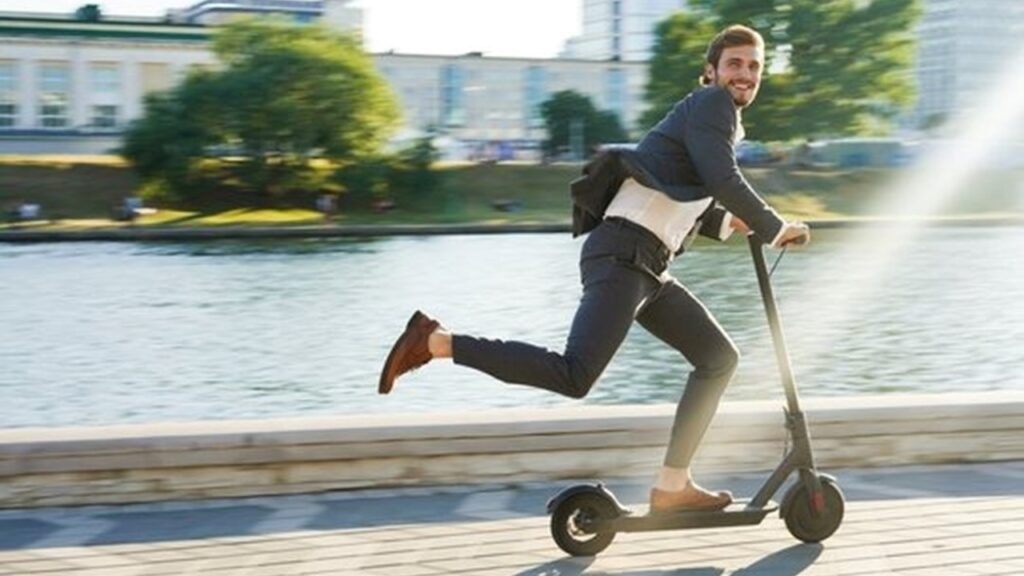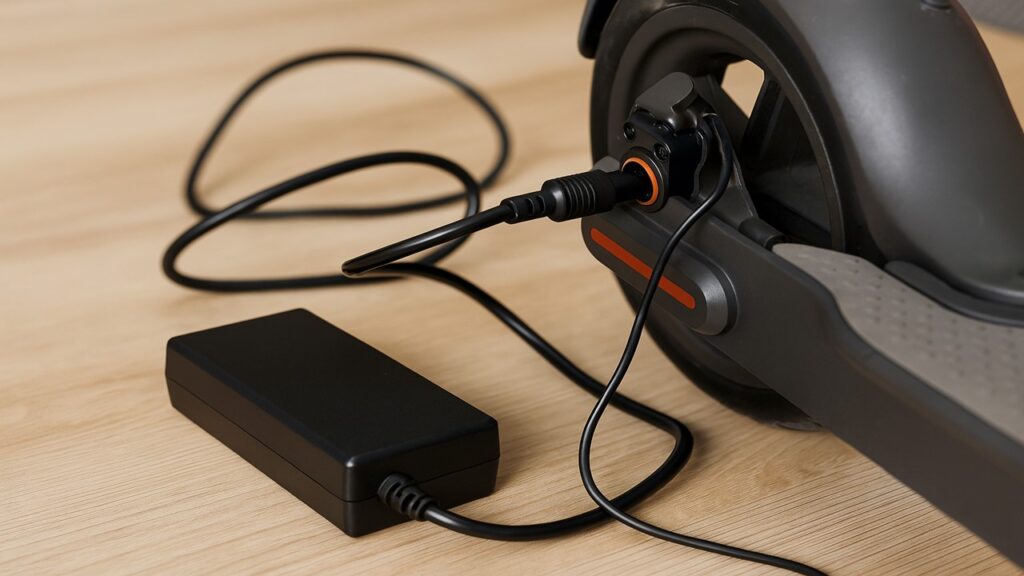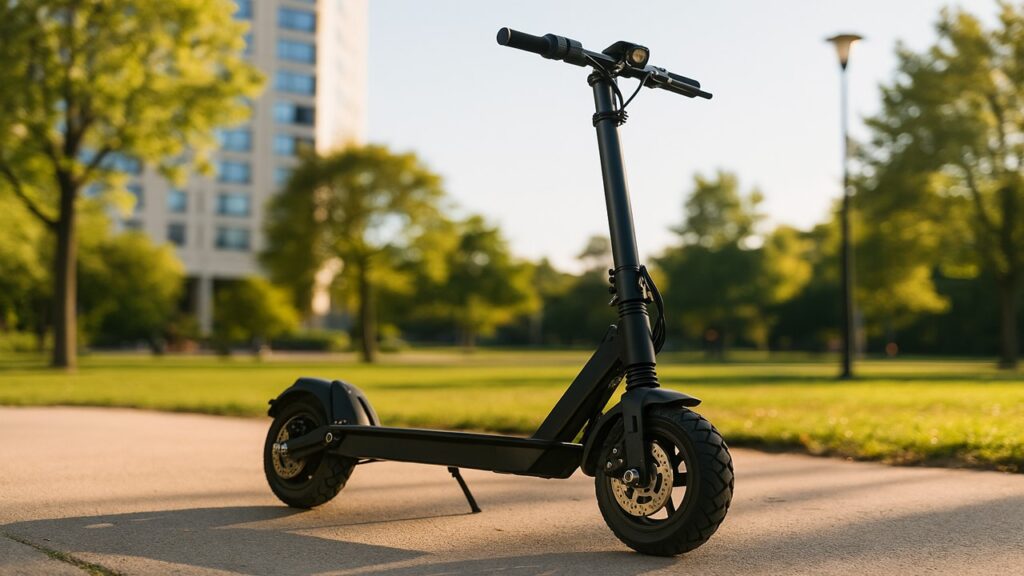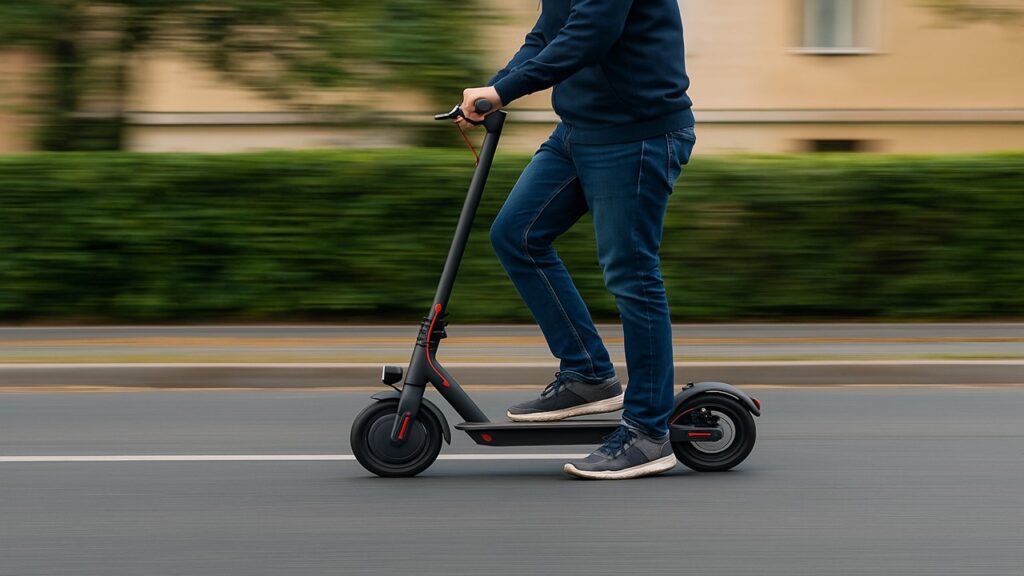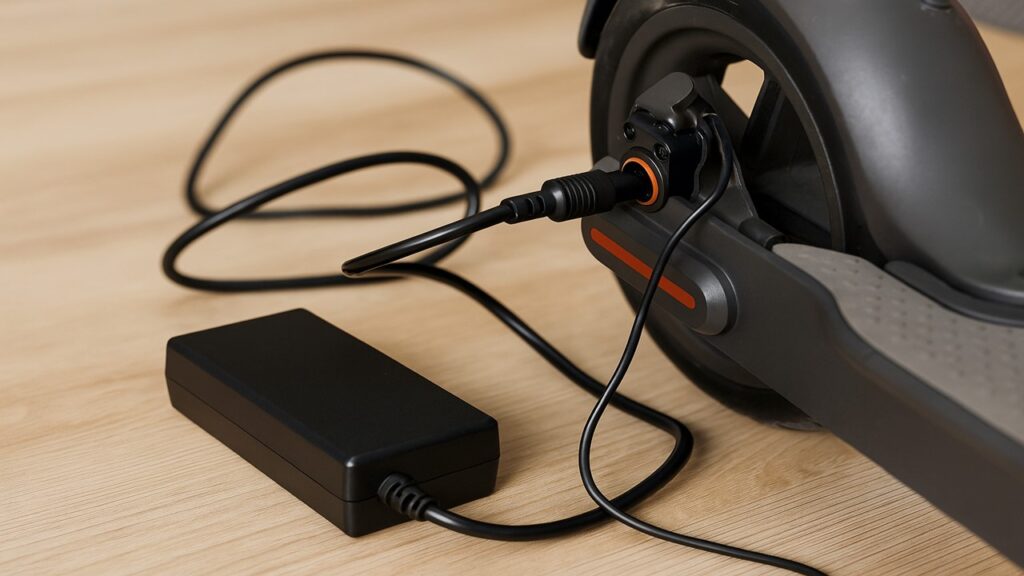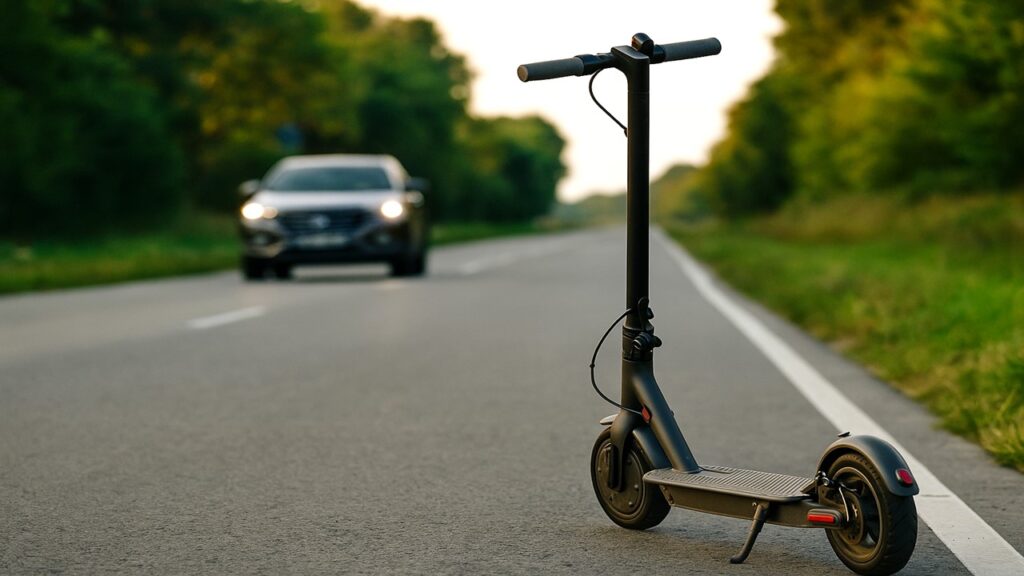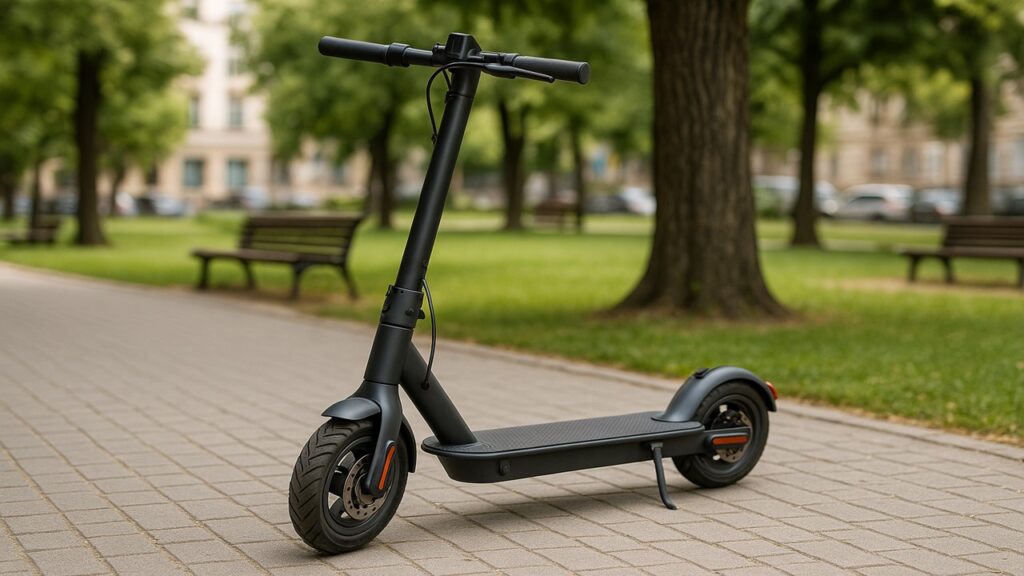
Most electric scooters weigh between 9 and 30 kilograms (20–65 pounds) depending on their design, materials, and purpose. Lightweight commuter models are easy to carry and store, while performance scooters are built with larger motors and batteries that add extra weight for speed and range.
Key Summary:
- Average Weight Range: Most electric scooters weigh between 9 and 30 kilograms (20–65 pounds), depending on their build, motor power, and battery size.
- Weight Categories: Lightweight models (9–16 kg) are easy to carry, mid-weight scooters (16–25 kg) balance range and comfort, and heavy-duty ones (30 kg +) focus on speed and durability.
- Performance Impact: A scooter’s weight affects acceleration, stability, range, and portability — heavier scooters often go faster and farther but are harder to lift and store.
- Best Fit by Rider Type: Choose lightweight scooters for commuting and portability, mid-weight for daily mixed use, and heavy-duty models for long-distance or off-road riding.
What Is the Average Weight of an Electric Scooter?
On average, most adult electric scooters weigh between 11 and 23 kilograms (25–50 pounds). This range represents typical commuter scooters designed for city travel and short to mid-distance rides. They strike a balance between portability and power, making them suitable for most urban users.
However, the weight can vary greatly depending on the category. Lightweight scooters focus on portability with compact batteries and foldable frames, while heavier models include dual motors, bigger batteries, and reinforced structures for enhanced performance. The key is choosing a weight that fits your lifestyle — lighter for daily carrying, heavier for speed and range.
| Scooter Type | Average Weight | Example Model | Key Feature |
| Lightweight / Portable | 9–16 kg (20–35 lbs) | Unagi Model One | Easy to carry and fold |
| Mid-weight / Commuter | 16–25 kg (35–55 lbs) | Segway G30 Max | Balanced range and comfort |
| Heavy-duty / Performance | 30 kg + (70 lbs +) | Dualtron X2 Up | Long range and high speed |
How Much Does an Electric Scooter Typically Weigh?
A typical commuter e-scooter weighs around 18 kilograms (40 pounds). This middle range is what most adults find manageable for both riding and carrying. It’s light enough to lift up a few stairs yet sturdy enough to deliver reliable speed and range.
Lightweight models like the Unagi Model One sit closer to 12 kilograms, ideal for apartment dwellers or short urban commutes. Mid-range options, such as the Segway Ninebot Max, weigh about 19 kilograms and offer longer range with improved comfort. On the other end, heavy-duty scooters like the Kaabo Wolf King GT exceed 45 kilograms, built for riders who value performance and stability over portability.
When comparing these categories, remember that the overall weight directly reflects design choices — lighter scooters prioritize convenience, while heavier models focus on endurance and power.
Types of Electric Scooters and Their Weight Categories
Electric scooters fall into three main categories based on their weight and purpose. These classes help riders identify which scooter suits their lifestyle best.
Quick overview:
- Lightweight scooters: portable, commuter-friendly
- Mid-weight scooters: balanced comfort and range
- Heavy-duty scooters: performance-driven and powerful
Let’s explore each type in more detail.
Lightweight / Portable Scooters (9–16 kg | 20–35 lbs)
Lightweight scooters are ideal for riders who need easy transport and quick storage. They’re built from aluminum or carbon fiber, with smaller batteries and motors that keep them efficient yet portable. Most fold within seconds and can be carried into offices or apartments.
Common examples include the Unagi Model One and GOTRAX GXL V2, both known for their sleek frames and reliable city performance. While they don’t offer extreme range or top speeds, they excel in practicality for short-distance commuting.
Mid-Weight / Commuter Scooters (16–25 kg | 35–55 lbs)
This category provides the perfect balance between performance and convenience. These scooters often come with larger batteries, enhanced suspension, and pneumatic tires for smoother rides. They deliver longer range without becoming too bulky.
The Segway Ninebot G30 Max and NIU KQi3 Pro are prime examples — strong enough for extended rides yet manageable for daily handling. These are the most common scooters for city commuters.
Heavy-Duty / Performance Scooters (30 kg + | 70 lbs +)
Heavy-duty scooters are engineered for serious riders. They include dual motors, long-range lithium batteries, and reinforced steel or aluminum frames for durability. Designed for higher speeds and off-road conditions, these scooters prioritize strength and performance over portability.
Models like the Kaabo Wolf King GT or Dualtron X2 Up can exceed 100 kilometers of range and 60 mph in top speed. However, they require more effort to transport and are better suited for experienced riders seeking long-range adventures or rugged terrain capability.
Factors That Influence an Electric Scooter’s Weight
The total weight of a scooter depends on how it’s built and what it’s built for. Four main components determine how heavy or light a model will be.
Key factors include:
- Battery size and capacity
- Motor type and number
- Frame material
- Suspension and tire design
Let’s look at each of these in more detail.
Battery Capacity
The battery is one of the heaviest components. Larger batteries provide longer range but add significant mass. For instance, a 250 Wh battery may add around 2 kilograms, while a 1500 Wh pack can add 8 kilograms or more. Commuter scooters typically balance this by using mid-size batteries to stay portable.
Motor Power
Scooters with powerful motors or dual-motor systems weigh more because they require additional wiring, housings, and cooling. A typical 350 W motor adds around 1.5 kilograms, while high-performance models with 1000 W dual motors can double that.
Frame Material
The material used for the scooter’s frame greatly affects its overall mass. Aluminum alloys are the most common because they’re light yet durable. Magnesium and carbon fiber reduce weight further but increase cost. Steel, while strongest, makes the scooter considerably heavier.
Suspension and Tire Size
Suspension systems and large pneumatic tires enhance ride comfort but add extra weight. Dual suspension setups can add 3–5 kilograms to a scooter’s frame. This tradeoff gives riders smoother handling on uneven roads at the cost of some portability.
How Weight Affects Scooter Performance
Weight plays a key role in how an electric scooter behaves on the road. It directly influences speed, range, braking, and handling. Understanding this relationship helps you choose a scooter that fits your riding style and comfort level.
Here’s how scooter weight impacts overall performance:
- Acceleration and Speed: Heavier scooters often house stronger motors and larger batteries, giving them higher top speeds and faster acceleration. Lightweight scooters are quick off the line in short bursts but can lose stability at higher speeds.
- Range: A bigger battery means longer range, but it also adds weight. Most lightweight scooters deliver 10–25 miles, while heavier ones can exceed 60–90 miles on a single charge.
- Braking and Stability: Extra mass improves traction and stability at speed, allowing smoother braking and cornering. However, it also means a slightly longer stopping distance.
- Portability and Control: Lighter scooters are easier to lift, fold, and store, making them ideal for commuting. Heavier ones handle bumps and inclines better but require more strength to maneuver.
Light vs Heavy Electric Scooters
The choice between a light or heavy scooter depends on your priorities. Lightweight models focus on convenience and portability, while heavy-duty scooters emphasize power and range. Both serve distinct types of riders.
| Feature | Lightweight | Heavy-Duty |
| Avg Weight | 9–16 kg | 30 kg + |
| Portability | High | Low |
| Range | 10–25 mi | 40–90 mi |
| Speed | 15–20 mph | 40–60 mph |
| Ideal For | Commuters | Enthusiasts / Off-road |
Which suits you best?
If you’re a daily commuter climbing stairs or carrying your scooter on public transport, go lightweight. For riders seeking speed, off-road capability, or long-distance performance, a heavier model is the better choice.
Real-World Examples: Popular Scooters and Their Weights
Electric scooter models vary widely in size and mass, depending on their intended use. Comparing actual specifications helps illustrate how weight aligns with performance, portability, and price.
| Model | Weight | Top Speed | Range | Category |
| Unagi Model One | 26 lbs (12 kg) | 20 mph | 15 miles | Lightweight / Commuter |
| GOTRAX G6 | 35 lbs (16 kg) | 18 mph | 20 miles | Mid-weight / City |
| Segway Max G30 | 41 lbs (19 kg) | 20 mph | 40 miles | Mid-weight / Long Range |
| Kaabo Wolf King GT | 101 lbs (46 kg) | 62 mph | 55 miles | Heavy-Duty / Performance |
| Dualtron X2 Up | 145 lbs (66 kg) | 68 mph | 93 miles | Extreme Performance |
These examples show that every kilogram adds both strength and capability. The difference between a commuter-friendly model and a performance machine often comes down to how much weight you’re willing to handle.
Expert Insight – How Weight Changes the Ride Feel
After testing multiple scooters across weight classes, one pattern stands out: scooter weight doesn’t just affect numbers on paper — it changes how the ride feels under your feet. Lightweight scooters respond quickly to steering and acceleration, giving an agile, playful experience. They’re perfect for city commutes, where quick turns and frequent stops are common.
Heavier scooters, on the other hand, deliver a more grounded and stable ride. The added weight helps absorb road vibration and provides confidence at high speeds. You feel less bounce on rough roads, and the scooter holds its line better during acceleration or braking. However, this stability comes with trade-offs — carrying a 45 kg scooter up a flight of stairs is not for everyone. The best ride is ultimately one that matches your strength, terrain, and distance needs.
Choosing the Right Scooter Weight for Your Needs
The ideal scooter weight depends on your lifestyle, strength, and how you plan to use it. Choosing the right balance between portability and performance makes daily riding safer and more enjoyable.
Quick considerations:
- How often will you carry your scooter (stairs, car, public transport)?
- What type of terrain or roads do you ride on most?
- Do you prioritize speed and range or convenience and portability?
- How much storage space do you have at home or work?
Let’s look at how different rider types can choose the best scooter weight for their needs.
For Apartment or Urban Riders
If you live in an apartment or use public transportation, go for a lightweight scooter under 16 kilograms. These models are easier to fold, lift, and store in tight spaces. Scooters like the Unagi Model One or Segway E22 are perfect for short city commutes. They may have smaller batteries, but they make up for it with portability and quick charging.
For Daily Commuters
Commuters who ride several miles daily should aim for mid-weight scooters between 16 and 25 kilograms. These provide a good mix of power, stability, and comfort. Models such as the Segway Ninebot G30 Max or NIU KQi3 Pro offer longer range and improved ride quality, without being too heavy to handle.
For Long-Range or Off-Road Riders
If you ride long distances or enjoy off-road trails, choose a heavy-duty scooter above 30 kilograms. These scooters include large batteries and powerful dual motors for sustained performance and better traction. Options like the Kaabo Wolf King GT or Dualtron X2 Up are built for speed, stability, and endurance, though they are less convenient to carry.
For Kids or Teens
Young riders benefit from ultra-light scooters under 10 kilograms. These are easy to control, safer for smaller users, and simple to store after use. While they don’t have high speeds or long range, they provide a great entry point into electric scooting for short distances.
Read more: Best electric scooters for teens
Final Words
Electric scooter weight defines how it feels to ride, carry, and store. The right model depends on what you value most — portability, speed, or endurance. For city commutes, lighter is better; for adventure or range, heavier models shine. Choose a scooter that matches your daily habits, not just the specs on paper.
FAQs
What is the average weight of an electric scooter?
Most electric scooters weigh between 9 and 30 kilograms, depending on their design and purpose. Commuter models generally fall around 18 kilograms.
Does a heavier scooter mean better performance?
Not always. Heavier scooters often have stronger motors and longer range, but they’re harder to carry and less practical for short trips.
What’s the lightest electric scooter available?
The Unagi Model One is among the lightest at around 12 kilograms, designed for portability and urban commuting.
Do lightweight scooters have shorter range?
Yes, because their smaller batteries store less energy. However, most lightweight models still offer enough range for short daily rides.
How much weight can an electric scooter support?
Most adult scooters handle up to 100–150 kilograms, depending on the frame and motor strength.

Max Volt is an electric scooter and e-bike enthusiast who rides daily and knows the nuts and bolts of every model. With years of hands-on repair experience and real-world testing, Max shares practical reviews, maintenance tips, and buyer guides to help riders choose the right gear with confidence. His mission is to make electric commuting safer, smarter, and more enjoyable for everyone.




